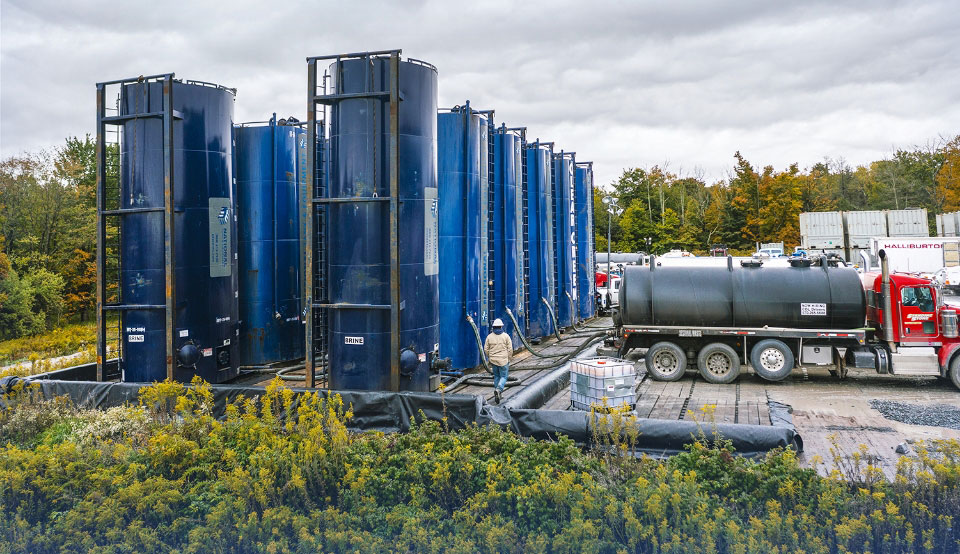Responsible Water Management
We are committed to high standards of water stewardship and conservation, efficiently recycling, reusing and disposing of water in a manner sensitive to local environmental, economic and regulatory concerns. We recognize and respect the importance of water to our communities and surrounding habitats, and partner with stakeholders to protect water resources. Read more about our commitment to water stewardship.
Water Consumption(1)(2)
| Total fresh water consumed (bbl) | Total recycled (non-fresh) water consumed (bbl) | Total water consumed (bbl) | Freshwater intensity rate (bbl/gross boe) | |
|---|---|---|---|---|
| Haynesville | ||||
| 2023 | 48,213,704 | 142,895 | 48,356,599 | 0.31 |
| 2022 | 44,849,652 | 63,124 | 44,912,776 | 0.31 |
| 2021 | 37,772,932 | 3,378 | 37,776,310 | 0.28 |
| Marcellus | ||||
| 2023 | 31,181,938 | 6,180,984 | 37,362,922 | 0.12 |
| 2022 | 31,328,060 | 5,559,322 | 36,887,382 | 0.12 |
| 2021 | 22,784,174 | 3,736,461 | 26,520,635 | 0.11 |
In 2023, we consumed nearly 103 million barrels of water at a water efficiency rate of 0.25 bbl/gross operated boe.
Water Management Process
Chesapeake manages water in accordance with state and federal requirements in our basins of operation. Whenever possible, we use non-potable water sources for our drilling and completions needs, sourcing from private landowners, municipalities, regional water districts and river authorities.
Demand
Chesapeake determines the completions design and water amounts needed to meet production forecasts (specific to each individual site).
Sourcing
Based on demand, sources of fresh water vs. non-fresh water are assessed and permitted accordingly.
Logistics
Water is metered and transported via pipeline or truck; water may move directly to operations or to a staging area prior to operational use.
Reporting
Water volumes are entered into internal databases and reported to the local and state entities per individual requirements.
End of Life
Produced water is either disposed, recycled or reused based on market capabilities and conditions.
Evaluating Water Stress
We monitor drought level indications as published and updated quarterly by the U.S. Geological Survey (USGS) and through the World Resources Institute (WRI)’s Aqueduct Water Risk Atlas.
In 2023, we didn’t source fresh water from any region classified as high or extremely high water-stress areas according to the WRI water risk assessment tool. Consistently, our Marcellus and Haynesville assets aren’t considered to be water-stressed areas.
Water Recycling
Chesapeake was one of the first of our peers to have a dedicated water recycling program and we continue to evolve our broader water recycling efforts. In line with the American Exploration and Production Council (AXPC), we define water recycling as water produced in the field and reused by field (drilling and completions) operations.
Our Marcellus operations team aim to recycle 100% of our produced water in Pennsylvania. We reuse our produced water for completions activities — helping to remove the need for disposal and reducing local freshwater usage. In 2023, Chesapeake recycled more than 6 million barrels of produced water.
We have also developed a produced water sharing program with other operators in the Marcellus basin. This allows us to accept produced water for use in our completions jobs from local E&P companies. This efficient reuse benefits the local operators as we provide them with alternatives to disposal.

In 2023, Chesapeake recycled more than 6 million barrels of produced water, including 100% of our produced water used in the Marcellus.
Water Sampling
Chesapeake’s robust approach to groundwater protection includes pre- and/or post-drill water quality sampling as appropriate. We comply with state regulations and lease obligations that require sampling, and we conduct risk-based sampling to further safeguard ground and surface water during operations including:
- Collection: Independent, third-party consultants collect landowner water samples near our production sites, which are then analyzed by a state or nationally accredited laboratory.
- Testing: We test water supplies for a predefined set of parameters, including general water quality indicators, biological parameters, metals, dissolved gases and petroleum constituents.
- Communication: Landowners receive an analytical data package that includes fact sheets, links to appropriate state environmental agency websites and the EPA Water Systems Council WellCare Hotline.
- Data Retention: Sampling results are stored in our extensive water quality database to help aid in decision-making on where and when to sample in the future.
FracFocus
We disclose the ingredients contained within completion fluids to state regulatory agencies and to the public on fracfocus.org. Since 2011, we have reported 100% of our well completions to FracFocus, a web-based registry that provides detail on completion process additives, chemicals and the amount of water used, as reported by oil and natural gas operators.
When reporting to FracFocus, Chesapeake utilizes information supplied to us by our vendors in the form of Safety Data Sheets. We encourage our additive suppliers to be as transparent as possible reporting both the actual additives used in their hydraulic fracturing operations and, separately, the individual chemistries contained in the additives.


